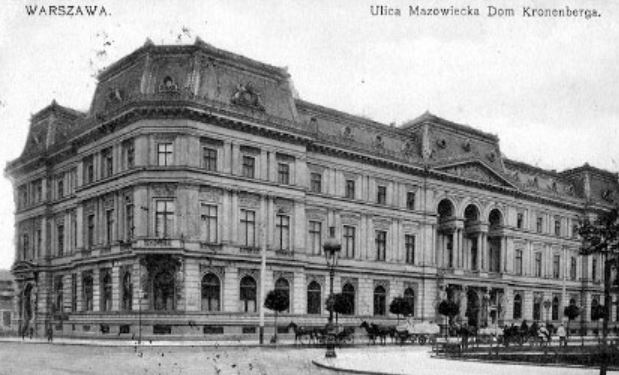Witajcie, przesuńmy się teraz na południe do okolic Placu Piłsudskiego, gdzie na rogu Placu Małachowskiego (d. Ewangelickiego) i ul. Królewskiej naprzeciwko „Zachęty” znajdował się Pałac Kronenberga.
Pałac zaprojektowany przez berlińskiego architekta Fridricha Hitziga został wybudowany w latach 1868-71, a stanął na miejscu osiemnastowiecznej kamienicy Augusta Wilhelma Arndta. Jego fasada została ozdobiona dekoracjami rzeźbiarskimi przez Leonardo Marconiego, bratanka Henryka Marconiego – znanego warszawskiego architekta, do którego z pewnością jeszcze wrócę. Do pałacu od strony ulicy Traugutta w pierwszych latach XX wieku dobudowano kamienicę Krasińskich według projektu architekta Jana Heuricha, ale o tym w następnym wpisie.
Dom Kronenberga, jak też był nazywany był niewątpliwie najbardziej luksusowym budynkiem mieszkalnym jaki powstał w 2 poł. XIX w. w Królestwie Kongresowym (zabór rosyjski).
Jego nazwa nie jest przypadkowa, ufundował go warszawski bankier i przemysłowiec Leopold Kronenberg, (m.in. twórca Banku Handlowego – dziś co roku 1 listopada na Powązkach przy jego mauzoleum można zobaczyć wieniec Citi Banku) gdzie mieszkał wraz z liczną rodziną. Po jego śmierci w 1878 pałac został częściowo przeznaczony pod wynajem (mieścił się w nim m.in. biura zarządu Kolei Nadwiślańskiej).
W dwudziestoleciu pałac przeszedł na własność Banku Polskiego. Do czasu budowy „Prudentialu” w pałacu miało swą siedzibę Towarzystwo ubezpieczeń na życie i od wypadków „Przezorność”. Tak ten sam ubezpieczyciel, który od paru lat znów jest aktywny w Polsce. W drugiej połowie lat trzydziestych był także siedzibą biura polskiej linii okrętowej Gdynia-Ameryka, a także poselstw Danii i Portugalii.
Los pałacu dopełnił się we wrześniu 1939 roku kiedy gmach spłonął od bomb zapalających, wyposażenie uległo zniszczeniu, ruiny zostały zabezpieczone i w takim stanie przetrwały wojnę.
Po wojnie pałac planowano odbudować, m.in. pojawiła się propozycja ulokowania w nim ambasady NRD. W 1958 gmach przekazano Francji z przeznaczeniem na ambasadę tego kraju, jednak Francuzi poinformowali stronę polską, że adaptacja istniejących murów pałacu jest niemożliwa. W 1959 Pałac Kronenberga został skreślony z rejestru zabytków.
Gmach został rozebrany w 1962 roku. Z pałacu po rozbiórce ocalały tylko cztery granitowe trzony kolumn, jednej z nich użyto do budowy Pomnika Electio Viritim na warszawskiej Woli (róg Obozowej i Ostroroga) upamiętniającego królewskie elekcje na polach, gdzie szlachta wyrażała swoją „wolę” (stąd nazwa dzielnicy :)).
Dwa pierwsze zdjęcia pokazują pałac od ulicy Królewskiej (z tyłu Ogród Saski) oraz od strony Placu Małachowskiego, następnie zdjęcia z parku miniatur, który od 1 maja zmienia swoją siedzibę na budynek dawnego Banku Landaua (ul. Senatorska 38). Kolejne to Google Earth – dzisiejszy układ z widoczną Viktorią oraz zdjęcie z 1945 roku, następnie rok 1960 i to co zostało z pałacu. Na koniec pomnik Electio Viritim na Woli oraz ostatnie – zrobione dziś z tego samego miejsca co pierwsze archiwalne.
Hello everyone, let’s move south now to the area around Piłsudski Square, where Kronenberg Palace stood on the corner of Małachowski Square (formerly Evangelical Square) and Królewska Street, opposite the Zachęta Gallery.
The palace, designed by Berlin architect Fridrich Hitzig, was built between 1868 and 1871 on the site of an 18th-century townhouse belonging to August Wilhelm Arndt. Its façade was adorned with sculptural decorations by Leonardo Marconi, nephew of Henryk Marconi – a renowned Warsaw architect, to whom I will certainly return. In the early 20th century, the Krasiński townhouse was added to the palace on the Traugutta Street side, designed by architect Jan Heurich, but more on that in the next post.
The Kronenberg House, as it was also called, was undoubtedly the most luxurious residential building built in the second half of the 19th century in the Congress Kingdom of Poland (Russian partition).
Its name is no accident; it was founded by the Warsaw banker and industrialist Leopold Kronenberg (among other things, the founder of Bank Handlowy – today, every November 1st, a wreath from Citi Bank can be seen at his mausoleum at Powązki Cemetery), where he lived with his large family. After his death in 1878, the palace was partially rented out (it housed, among other things, the offices of the Vistula Railway management).
In the interwar period, the palace became the property of the Bank of Poland. Until the construction of the Prudential building, the palace housed the headquarters of the „Przezorność” („Prudence”) life and accident insurance company. This same insurer some years ago became active in Poland again. In the second half of the 1930s, it also housed the office of the Polish shipping line Gdynia-Ameryka, as well as the Danish and Portuguese embassies.
The palace’s fate was sealed in September 1939 when it burned down due to incendiary bombs, its furnishings were destroyed, and the ruins were secured and survived the war in this condition.
After the war, there were plans to rebuild the palace, including a proposal to house the East German embassy there. In 1958, the building was transferred to France to serve as its embassy, but the French informed the Polish side that adapting the existing palace walls was impossible. In 1959, Kronenberg Palace was removed from the register of historic monuments.
The building was demolished in 1962. Only four granite column shafts survived the demolition, one of which was used to build the Electio Viritim Monument in Warsaw’s Wola district (corner of Obozowa and Ostroróg streets), commemorating royal elections in the fields where the nobility expressed their „will” (hence the name of the district).
The first 2 photos show the palace from Królewska Street (Saxon Garden behind) and from Małachowski Square. Then, photos from the miniature park, which, as of May 1st, is being relocated to the former Landau Bank building (Senatorska Street 38). The next photos are from Google Earth – today’s layout with the Victoria Palace visible, and a photo from 1945. Then, 1960 and what remains of the palace. Finally, the Electio Viritim monument in Wola, and the last – taken today from the same spot as the first archival photo.

